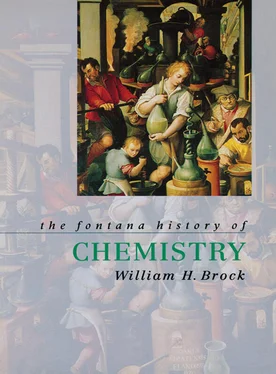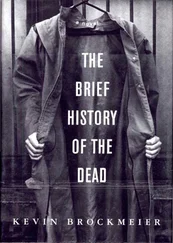This radical reconceptualization of composition was immediately challenged by a fellow Frenchman, Joseph-Louis Proust (1754–1826), who worked as an analyst in Spain. In a long series of meticulous analyses and friendly challenges to Berthollet, Proust argued that there was overwhelming evidence that regular compounds were formed from their constituents in fixed and definite proportions. There might well be more than one compound of the same two substances, but their proportions were regular.
Although neither contender gained a definite victory (for Berthollet was perfectly correct in his position over some of the difficult substances like glasses that he examined), by 1810, and in the light of Dalton’s theory, it was seen that the laws of definite and multiple proportions offered a securer foundation for quantitative chemistry. For the time being Berthollet’s views, which were eventually to illuminate physical chemistry and the theory of semiconductors, served only to confuse and handicap the development of analytical chemistry, which was so beguilingly explained by Dalton’s theory.
In 1808 William Hyde Wollaston and Thomas Thomson provided further convincing experimental examples of multiple proportions when they showed that there was a 2 : 1 ratio of CO 2in the bicarbonate and carbonate of potassium (viz. KHCO 3or K 2O.2CO 2.H 2O and K 2CO 3or K 2O.CO 2), and, for the same amount of acid in the normal and acid oxalates of potash and strontia, there was double the amount of base in the acid oxalates.
It was in the context of this experimental work with oxalates that Thomson recommended Dalton’s chemical atomism, having already briefly referred to it in the third edition of his important textbook, System of Chemistry , in 1807. Thomson’s initial account was based directly on conversations Thomson had had with Dalton in Manchester in 1804. Soon afterwards Dalton had read an account of his first list of atomic weights in a paper read to the Manchester Literary and Philosophical Society in October 1803 (published with differences in 1805). Thomson was also directly responsible for inviting Dalton to Scotland in 1807 to lecture on his views on air, heat and chemical synthesis to audiences at the Universities of Edinburgh and Glasgow. It was these lectures that led to the New System.
Although Dalton’s brilliant insight was developed by others, it is worth emphasizing that he retained other imaginative insights that remained undeveloped for decades. In particular, it is clear from surviving remnants that Dalton built models of atoms and compounds in order to illustrate his theory. This model-building followed directly from his first thoughts on mixed gases in 1803 4 :
When an element A has an affinity for another B, I see no mechanical reason why it should not take as many atoms of B as are presented to it, and can possibly come into contact with it (which may probably be 12 in general) except so far as the repulsion of the atoms of B among themselves are more than a match for the attraction of an atom of A. Now this repulsion begins with 2 atoms of B to 1 of A, in which case the 2 atoms of B are diametrically opposed; it increases with 3 atoms of B to 1 of A, in which case the atoms of B are only 120° asunder; with 4 atoms of B it is still greater as the distance is then only 90°; and so on in proportion to the number of atoms. It is evident then from these positions, that, as far as powers of attraction and repulsion are concerned (and we know of no other in chemistry) binary compounds must first be formed in the ordinary course of things, then ternary , and so on, till the repulsion of the atoms of B (or A, whichever happens to be on the surface of the other), refuse to admit any more.
This statement shows that Dalton’s apparently intuitive appeal to a principle of simplicity in chemical synthesis was backed up by a geometrical force model – a model that, in a radically different setting, was to be used by ligand-field theorists a century and a half later. But it was entirely speculative, and, although it gave ‘order’ to Dalton’s symbols, it was not a path that the empirically minded Berzelius was to follow in his own symbolic language.
ELECTRIFYING DALTON’S THEORY
Dalton presented his theory within the context of ideas concerning heat at a time when the chemical world had become excited by the news of galvanic or current electricity. In 1800 the Italian physicist, Alessandro Volta (1774–1827), described his ‘voltaic pile’ or battery in a paper published by the Royal Society. This simple machine made from a ‘pile’ or ‘battery’ of alternating zinc and silver discs gave chemists a powerful new analytical tool. As Davy said later, its use caused great excitement and it acted as ‘an alarm-bell to experimenters in every part of Europe’. Almost immediately it was found that the battery would decompose water into its elements. While there was nothing extraordinary about this further confirmation of Lavoisier’s chemistry, the puzzling fact was that hydrogen and oxygen were ejected from the water at different poles – the hydrogen at what Volta designated as the negative pole, and the oxygen at the positive pole. Two chemists who particularly concerned themselves with this galvanic phenomenon (the term ‘electrolysis’ was not coined by Faraday until 1832) were Davy and Berzelius.
Humphry Davy (1778–1829) was born at Penzance in Cornwall and educated locally. Intending to qualify as a doctor, he was apprenticed to a surgeon in 1795 and began to read Lavoisier’s Elements of Chemistry in French in his spare time. Though ignorant and completely self-taught, like Priestley before him, Davy began to repeat, correct and devise new experiments. Apart from this growing interest in chemistry, he wrote poetry (for this was the era of Romanticism when young men poured forth their individual feelings in verse), he admired the rich Cornish scenery and he fished. Through a friendship with Gregory Watt, the tubercular son of James Watt, Davy came to the attention of Thomas Beddoes, a pupil of Joseph Black and a former lecturer in chemistry at the University of Oxford, who had resigned from ‘that place’ because of his support for the French Revolution and his suspiciously radical politics. In 1798 Beddoes, convinced that the many gases that Priestley had discovered might prove beneficial in the treatment of tuberculosis (TB) and other urban diseases, founded a subscription-based Pneumatic Institute in Bristol. He persuaded Davy, whom he recognized as a man of talent, to join him as a research assistant. Davy probably still expected to qualify as a doctor, perhaps by saving sufficient money to enter Edinburgh University as a result of this experience. In the event, he became a chemist.
Davy’s risky and foolhardy experiments at Bristol, in which he narrowly escaped suffocation on several occasions, brought him fame and notoriety in 1800 when he published his results in Researches, Chemical and Philosophical; Chiefly Concerning Nitrous Oxide … and its Respiration. None of his inhalations demonstrated chemotherapeutic benefits – though his results with nitrous oxide (laughing gas) were to be the cause of regular student ‘saturnalia’ in chemical laboratories throughout the nineteenth century. Not until 1846 was the gas used as an anaesthetic. This inhalation research, and some further essays published in 1799, which included an attack on Lavoisier’s notion of caloric and the substitution of light for caloric in gaseous oxygen (phosoxygen), brought Davy’s name to the attention of another patron, Benjamin Thompson, who had also denied that heat was an imponderable fluid.
Count Rumford, as he is better known, had founded the Royal Institution in London in 1799 as a venue for publicizing ways in which science could help to improve the quality of life of the deserving poor and for the rising middle classes. By 1801 Rumford needed a new Professor of Chemistry. Davy’s appointment coincided with the wave of contemporary interest in electrolytic phenomena and, although he lectured, dazzlingly, on many other subjects at the Royal Institution, it was his research on electrochemistry that captured the public’s imagination and ensured the middle-class success of the Institution.
Читать дальше












